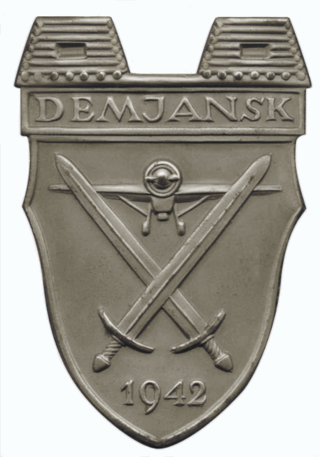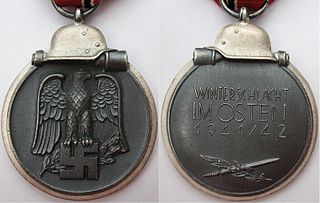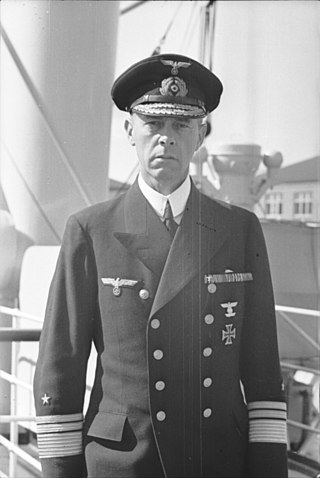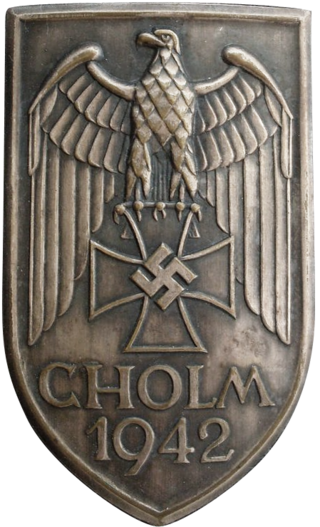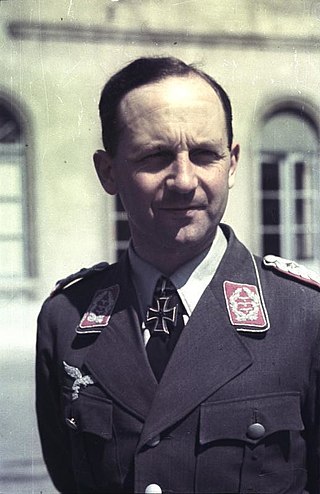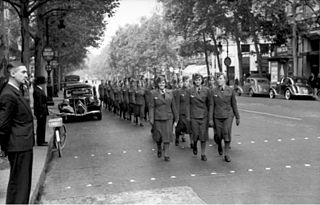Wehrmacht
The first female auxiliary service in the Wehrmacht was the Army signals communications female auxiliaries, formed on 1 October 1940. Others followed suit, in the army and in the other services. Until December 1941, recruitment was by volunteer enlistment, but by that date unmarried women in the age group 18–40 years could be drafted into auxiliary service. [1] All female auxiliary services were uniformed and under military discipline, with free rations, quarters and clothing. Yet, they were paid according to civil service pay rates and were not considered members of the armed forces, but auxiliaries of the armed forces. Their ranks did not correspond to military ranks. [2]
Army
- Nachrichtenhelferinnen (NH) des Heeres
Army signals communications female auxiliaries.
| Insignia (1940–1942) | | | | | | No insignia | ||||
| NH-Hauptführerin | NH-Oberführerin | NH-Führerin | NH-Unterführerin | NH-Oberhelferin | Nachrichtenhelferin | |||||
| Insignia (1942–1945) [3] | | | | | | | | | | No insignia |
| NH-Oberstabsführerin | NH-Stabsführerin | NH-Hauptführerin | NH-Oberführerin | NH-Führerin | NH-Unterführerin | NH-Haupthelferin | NH-Oberhelferin | NH-Vorhelferin | Nachrichtenhelferin |
Navy
| Insignia [4] | | | | | | | | | No insignia |
| Marineoberstabsführerin | Marinestabsführerin | Marinehaubtführerin | Marineoberführerin | Marineführerin | Marinehaupthelferin | Marineoberhelferin | Marinevorhelferin | Marinehelferin |
Air force
- Flugmeldediensthelferinnen (FMDH)
Female air warning service auxiliaries
| Insignia (6 July 1940–2 August 1940) [5] [6] |  |  |  |  | No insignia | |
| Hauptgruppenführerin (Senior work group officer) | Betriebsgruppenführerin (Work group officer) | Aufsicht (Warden, supervisor) | Helferin (Female auxiliary) | Anwärterin (Applicant) | ||
| Insignia (2 August 1940–26 February 1941) [7] |  |  |  |  |  | No insignia |
| Kameradschaftsführerin (Comradeship leader) | Betriebsgruppenführerin (Work group officer) | Betriebsgruppenunterführerin (Work group junior officer) | Aufsichtshelferin (Female supervisor auxiliary) | Flugmeldehelferin (Female air warning auxiliary) | Anwärterin (Applicant) |
On 26 February 1941, the Flugmelde-Helferinnen were incorporated into the Luftnachrichtenhelferinnen (Luftwaffe female signals communications auxiliaries).
- Luftnachrichtenhelferinnen (LNH)
| Insignia [8] | | | | |
| Luftnachrichten-Flugmelde | Luftnachrichten-Flugmelde-Stabsführerin | Luftnachrichten-Flugmelde-Hauptführerin | Luftnachrichten-Flugmelde-Oberführerin | Luftnachrichten-Flugmelde-Führerin |
|---|---|---|---|---|
| Luftnachrichten-Betriebs | Luftnachrichten-Betriebs-Oberführerin | Luftnachrichten-Betriebs-Führerin | ||
| Insignia [8] | | | | |
| Luftnachrichten-Flugmelde | Luftnachrichten-Flugmelde-Haupthelferin (major plane spotter auxiliary) | Luftnachrichten-Flugmelde-Oberhelferin (senior plane spotter auxiliary) | Luftnachrichten-Flugmelde-Helferin (plane spotter auxiliary) | Luftnachrichten-Flugmelde-Anwärterin (applicant) |
| Luftnachrichten-Betriebs | Luftnachrichten-Betriebs-Haupthelferin (major plane spotter auxiliary) | Luftnachrichten-Betriebs-Oberhelferin (senior plane spotter auxiliary) | Luftnachrichten-Betriebs-Helferin (plane spotter auxiliary) | Luftnachrichten-Betriebs-Anwärterin (applicant) |
- Flakwaffenhelferinnen
Female anti-aircraft auxiliaries 1944.
| Insignia [9] | | | | | | | | No insignia |
| Flakw. Stabsführerin | Flakw. Hauptführerin | Flakw. Oberführerin | Flakw. Führerin | Flakw. Obertruppführerin | Flakw. Truppführerin | Flakw. Oberhelferin | Flakw. Helferin |
- Luftschutzwarndiensthelferinnen
Civil defence air-raid warning service female auxiliaries.
| Insignia [10] | | | | | No insignia |
| LS-Warndienst-Oberführerin | LS-Warndienst-Führerin | LS-Warndienst-Hapthelferin | LS-Warndienst-Oberhelferin | LS-Warndienst-Helferin |
Wehrmachthelferinnenkorps
On 29 November 1944 all female auxiliary organizations, except the Civil defence air-raid warning service female auxiliaries, were merged into one corps, the Wehrmacht Female Auxiliary Corps. [11]
| Insignia [12] |  | |  | | | | | | | No insignia |
| Oberstabsführerin | Stabsführerin | Hauptdienstführerin | Oberdienstführerin | Dienstführerin | Obertruppführerin | Truppführerin | Haupthelferin | Oberhelferin | Helferin |






